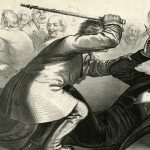 Technology
Technology  Technology
Technology  Humans
Humans 10 Everyday Human Behaviors That Are Actually Survival Instincts
 Animals
Animals 10 Animals That Humiliated and Harmed Historical Leaders
 History
History 10 Most Influential Protests in Modern History
 Creepy
Creepy 10 More Representations of Death from Myth, Legend, and Folktale
 Technology
Technology 10 Scientific Breakthroughs of 2025 That’ll Change Everything
 Our World
Our World 10 Ways Icelandic Culture Makes Other Countries Look Boring
 Misconceptions
Misconceptions 10 Common Misconceptions About the Victorian Era
 Mysteries
Mysteries 10 Strange Unexplained Mysteries of 2025
 Miscellaneous
Miscellaneous 10 of History’s Most Bell-Ringing Finishing Moves
 Technology
Technology Top 10 Everyday Tech Buzzwords That Hide a Darker Past
 Humans
Humans 10 Everyday Human Behaviors That Are Actually Survival Instincts
 Animals
Animals 10 Animals That Humiliated and Harmed Historical Leaders
Who's Behind Listverse?

Jamie Frater
Head Editor
Jamie founded Listverse due to an insatiable desire to share fascinating, obscure, and bizarre facts. He has been a guest speaker on numerous national radio and television stations and is a five time published author.
More About Us History
History 10 Most Influential Protests in Modern History
 Creepy
Creepy 10 More Representations of Death from Myth, Legend, and Folktale
 Technology
Technology 10 Scientific Breakthroughs of 2025 That’ll Change Everything
 Our World
Our World 10 Ways Icelandic Culture Makes Other Countries Look Boring
 Misconceptions
Misconceptions 10 Common Misconceptions About the Victorian Era
 Mysteries
Mysteries 10 Strange Unexplained Mysteries of 2025
 Miscellaneous
Miscellaneous 10 of History’s Most Bell-Ringing Finishing Moves
10 Crucial Events That Defined Entire Eras of American History
Certain events have very clearly defined American history. The Battle of Gettysburg, the bombing of Pearl Harbor, the assassination of public figures like Martin Luther King Jr. and John F. Kennedy—certainly, the list goes on from there. But just as much, there have been quite a few incredibly important events that have defined American history, which have been more or less forgotten in the modern age.
Here’s what we mean. Do you know anything about the Whiskey Rebellion? What about how it impacted nearly every American’s life for the decade after it happened? What about the Battle of New Orleans or the Treaty of Guadalupe Hidalgo? We don’t mean to act like a teacher giving out a pop quiz. We’re merely asking the question to prove our point: that many massive events in American history have both changed the course of the country and been completely forgotten by the masses.
In this list, we’ll try to rectify that a bit. Below are ten major events in American history that directly affected life in the United States for the next decade (and, if we’re being honest, long after that). These ten things may not have the household name status of things like Pearl Harbor or the September 11 terror attacks, but they were incredibly impactful nonetheless. And you ought to know about them!
Related: 10 Crazy Conspiracy Theories from Early American History
10 The Whiskey Rebellion (1794)
The United States was just beginning to work out its place in the world in the 1790s when a rebellion broke out in western Pennsylvania. The issue at hand was an uprising by locals there who didn’t want to pay a liquor tax that had been imposed by the federal government. They were mad at the Secretary of the Treasury (none other than Alexander Hamilton!) and refused to pay. Hamilton wanted to pay off the national debt by increasing taxes on certain products, like liquor. He also wanted to assert the power of the newly formed federal government in America’s nascent years. But citizens in western Pennsylvania wanted none of it.
So, they rebelled. In turn, President George Washington sent troops into the area in 1794 to quell the rebellion. Many people in the area and nationwide alike were appalled that federal troops would be used against their own citizens like that. Many critics, including Thomas Jefferson, saw the incident as a very early example of government overreach. Washington’s troops “won” the rebellion. But the cost was far more significant than just being able to levy a liquor tax. Forever after, that moment in time set the tone for the imposing powers of the United States federal government. The feds used their power to prove that they had the right to impose taxes as well as enforce laws. From there, they never looked back.[1]
9 The Louisiana Purchase (1803)
For those who know anything about American history, it might seem obvious that the Louisiana Purchase would be mentioned here. But it’s really worth stating just how impactful it was for the history and future of the United States. At the time, in 1803, President Thomas Jefferson rightly recognized that the Mississippi River and its release into the Gulf of Mexico at New Orleans was a natural driver of economic power. So he wanted New Orleans as a port to promote American power and might. The French were ready to part with more than that, though. So much more than that.
When Jefferson hit up Napoleon about buying New Orleans and its environs, the French leader shocked the American president by instead offering up more than 800,000 square miles (2.07 million square km) of land. Pretty much the entire western Mississippi River basin was for sale. Smartly, Jefferson jumped right on it. For a cool $27 million, the United States pried away a ton of land from the far-off French. In turn, the states of Louisiana, Arkansas, Missouri, Oklahoma, Iowa, Nebraska, South Dakota, and North Dakota were formed in time. Portions of states, including Kansas, Colorado, Wyoming, Minnesota, and Montana, came, too. It also set the stage for expeditions like that of Lewis & Clark to traverse across the country to the Pacific Coast.
We don’t need to belabor the point, but the Louisiana Purchase was arguably the biggest turning point in American history—at least as far as American expansion is concerned. It gave settlers the simple and seamless ability to move west and strike out into new territory. It brought about decades of furious fighting and tragic consequences for the Native American populations, too—a phenomenon that would come to define the entire rest of the 19th century. In time, it opened up America all the way to the West Coast.[2]
8 The Battle of New Orleans (1815)
The War of 1812 was fought between the Americans and the British as something of a redo of the American Revolution. It’s quite a bit more complicated than that, of course, but we’ll go with it. But by early 1815, that war had all but petered out. Here’s the thing, though: it was mostly a draw. At the time, the conflict had been a bit of a struggle for both sides to assert dominance. In late 1814 (on Christmas Eve, to be exact), the Americans and the British met in Europe to sign the Treaty of Ghent and end the whole thing once and for all.
Except news of that treaty didn’t reach mainland America for some time after that. And it certainly didn’t reach New Orleans for a while after. No internet back then and all that. So, on January 8, 1815, Commander Andrew Jackson very decisively defeated British forces in what came to be known as the Battle of New Orleans. Even though the war itself was over, none of the combatants knew it yet. The American victory was so grand and so all-encompassing that it left no doubt about which army was the more powerful one at the time.
This ended up mattering in two major ways for several decades after. First, it was the first major waypoint in Andrew Jackson’s rise to power. He became a famous national figure thanks to the battle win. And later, of course, he became the president. In addition, the battle left the Americans (and the whole world, to be honest) feeling as though they’d decisively won the war. They really hadn’t, but they were able to end things on such a high note that the momentum carried them militarily for the next several decades. And all from a battle that was fought more than two weeks after a treaty was signed.[3]
7 The Treaty of Guadalupe Hidalgo (1848)
On February 2, 1848, the Treaty of Guadalupe Hidalgo was signed. It officially brought about an end to the Mexican-American War, for one. However, the real benefit of the treaty was that it added more than 525,000 square miles (1.36 million square km) of land in the American West and southwest to the United States’ borders. Massive parts of what would become the states of California, Arizona, and New Mexico were added to the American experiment. In one fell swoop, with the simple swipe of a pen, President James K. Polk’s delegates at the treaty signing took over a whopping 55% of Mexican land previously held by that nation.
Obviously, just like the Louisiana Purchase, it can’t really be understated just how important the treaty signing was for America. Manifest Destiny was a key concept going around at the time, and President Polk’s shrewd move to take America coast-to-coast churned that push into overdrive. Soon, settlers from the east were going as fast as they could across the Great Plains (which, to be fair, wasn’t very fast in those old covered wagons) to secure land for themselves and settle new parts of the United States. And in the end, it gave us southern California—which, depending on your perspective, might either be a very good thing or a very bad thing. Thanks, Mexico![4]
6 The Battle of the Little Bighorn (1876)
On June 25, 1876, the 7th Unit of the United States Cavalry led by Lieutenant Colonel George Armstrong Custer took on Lakota and Northern Cheyenne warriors in a fight. Those warriors were led by the infamous Native American soldier Sitting Bull, and they trounced Custer and his men. Of course, we all learn (or… should have learned) about the battle in school. It was a rout, and Custer’s name became both a cautionary tale and a punchline for decades after.
But even though the victory at the time was a major boon for various Northern Plains Indian groups, the downstream effects were significant. Call it one of those “you may have won the battle, but you didn’t win the war” situations.
After the rout of Custer’s men, the United States went headlong into expansionism out west and got very aggressive in ending Native American sovereignty there. Obviously, even if Custer had won, the Americans still would have kept encroaching. But the brutal loss at Little Bighorn ensured that the Americans pushed west further, faster, and much more aggressively over the next several decades than they otherwise would have.[5]
5 The Haymarket Affair (1886)
During the latter half of the 19th century, the so-called “robber barons” of the United States began to amass previously untold amounts of wealth. Industrial activity and corporate growth combined to allow them to live very, very well. And increasingly, the poor and unfortunate workers who were left to staff the factories endured poverty wages, no time off, and horrific working and living conditions. That came to be known as the Gilded Age. There were a million different tensions and concerns during it—mainly from left-leaning workers trying to organize their labor into unions and fight back against the robber barons’ total control of life in America’s biggest cities.
Enter the Haymarket Affair in Chicago in 1886. It started as one of hundreds of labor strikes that went on during the 1880s as factory workers got more and more fed up with how they were treated. But the Haymarket Affair, in particular, quickly devolved into a riot. And then, it was totally disrupted by a bomb that exploded there and which killed seven Chicago policemen. The aftermath of that bombing ended up creating a very long and challenging set of consequences. Most notably, for our purposes here, the public soured so much on organized labor that it set back the worker’s rights movement until well into the 20th century.[6]
4 Plessy v. Ferguson (1896)
After the Civil War ended in 1865, Reconstruction eventually took hold. The 1870s and the next several decades after that were defined by the beginnings of Jim Crow laws in the Deep South. Those had deleterious effects on the lives of African Americans who were trying desperately to make their way forward as former slaves. Then, in May of 1896, everything was turned up a notch. The US Supreme Court ruled in a 7-1 decision in the Plessy v. Ferguson case that southern state laws designed to achieve racial segregation were, in fact, legal. The key there was the “separate but equal” component, which claimed that separate (and supposedly equal) facilities were acceptable for Black and White people to be kept apart.
The decision was a landmark one, pretty much right from the start. Bathrooms, water fountains, lunch counters, and nearly everything else in the South went the way of “separate but equal.” That Supreme Court decision, more than nearly any other decision the court has ever made, would be felt by millions and millions of people over the next six decades. Eventually, the Civil Rights movement of the 1950s and 1960s took hold. But even that was a struggle and a fight. The Supreme Court’s ruling back in 1896 created an inconceivable butterfly effect across the United States for nearly 70 years afterward.[7]
3 Breakup of Northern Securities (1902–04)
Remember the Haymarket Affair that we just covered a few bullet points back? Well, the aftermath of that situation finally began to come around 16 years later, in 1902. That year, President Theodore Roosevelt took action to curb the increasingly immense economic and political power of a series of giant corporate trusts that had been created over the previous few decades. To do so, he resurrected the almost-defunct Sherman Antitrust Act. Specifically, he aimed it at one company, the Northern Securities Company.
That was a massive railroad conglomerate that had been enjoying all the benefits of an economic monopoly. Its executives and leaders were reaping massive rewards from the company’s previously unfettered existence, while regular folks were getting nothing. Teddy didn’t care for that, so he filed an antitrust lawsuit against the company. And by 1904, he had won.
That year, the U.S. Supreme Court ordered the breakup of the Northern Securities Company and the end of their massive monopoly. In turn, President Roosevelt celebrated the landmark victory by going after nearly four dozen other major corporations over the next seven years with similar antitrust lawsuits. The 1900s and 1910s would thus come to be defined as the decades when corporate power was (finally) forced to fall back, and the average American worker was able to gain the slightest foothold in the growing economy.[8]
2 The Sinking of the Lusitania (1915)
During the first few years of The Great War, which later came to be known as World War I, the battle raged in Europe with no sign of stopping. But thousands of miles away and with an ocean separating them, the Americans were none too eager to get involved. They didn’t want to fight in that vicious war, and President Woodrow Wilson was doing everything in his power to keep them out of it. Through it, the US was publicly committed to a policy of neutrality in the fight. But to be fair, the Americans had positively benefited from Europe’s malaise. Supplying food, raw materials, guns, and ammunition to the Europeans had put the American economy into overdrive.
That all changed on May 7, 1915, when a German submarine sank the unarmed and civilian-carrying British ocean liner Lusitania in the North Atlantic Ocean. The Americans (and the rest of the world, too) were appalled at the sinking. And it certainly didn’t help that 128 innocent Americans were killed when the ship went down. So, out of isolation came the American troops. President Wilson’s men joined up against the Germans, and the rest was history. After a long and bloody war with millions dead all across the European continent, that is. After the long-simmering post-war situation, it led to World War II, as well. Talk about endless waves rippling out from the one-time sinking of a single ship.[9]
1 PATCO Strike (1981)
In 1981, the Professional Air Traffic Controllers Association (PATCO) went on strike. Their labor union felt that they were working too hard for much too little in pay and benefits, and so they walked out on work. That was a big deal for a lot of reasons—not the least of which was that air traffic control rooms were suddenly in peril with thousands of flights to be sent off and landed safely all across the country. Plus, federal workers and government employees had been prevented by law from striking—a law set nearly three decades before the PATCO labor push. However, the air traffic controllers wanted to test that law and their overall bargaining power. So, they went on strike.
What happened next was then-current President Ronald Reagan’s complete and total triumph over the poor PATCO laborers. He beat back the strike by August 1981. In turn, two major things happened that would affect America for the next decade and then some: the power of Reagan’s administration in Washington was nearly unquestionable, and labor unions across all sectors saw a major decrease in their own ability to bargain and gain protections for workers. In turn, Reagan went full bore into supply-side and monetarist economic policies by lowering taxes on the wealthy so-called “job creators” at the top of the pyramid. In many ways, the rest of us are all still feeling the effects of that series of events today.[10]








